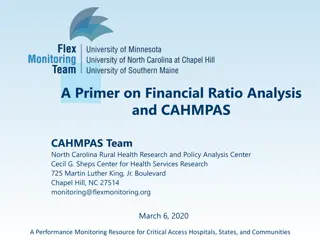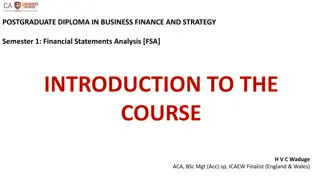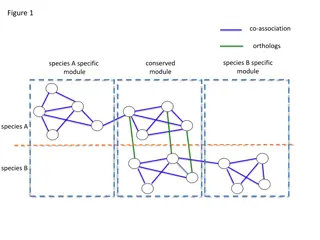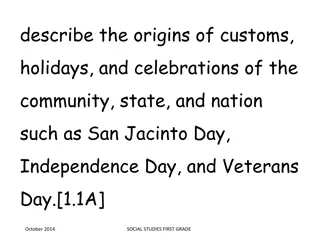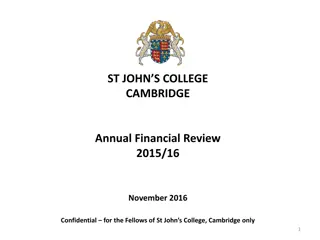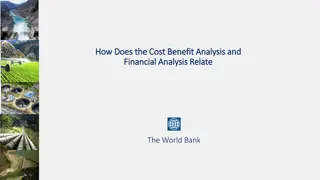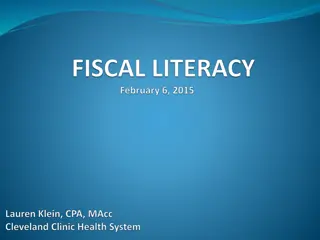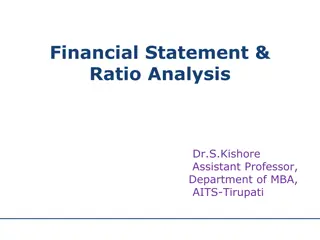Financial Figures and Analysis
Analyzing countrywide financial figures including assets, liabilities, surpluses, and leverage ratios. Detailed breakdown for 2010, 2009, and 2008 including net premiums earned, net losses incurred, underwriting expenses, investment incomes, and taxes incurred.
Download Presentation

Please find below an Image/Link to download the presentation.
The content on the website is provided AS IS for your information and personal use only. It may not be sold, licensed, or shared on other websites without obtaining consent from the author.If you encounter any issues during the download, it is possible that the publisher has removed the file from their server.
You are allowed to download the files provided on this website for personal or commercial use, subject to the condition that they are used lawfully. All files are the property of their respective owners.
The content on the website is provided AS IS for your information and personal use only. It may not be sold, licensed, or shared on other websites without obtaining consent from the author.
E N D
Presentation Transcript
Joseph L. Petrelli, ACAS, MAAA President & Co-Founder, Demotech, Inc. Buckeye Actuarial Continuing Education Inaugural Meeting, April 26, 2011
Countrywide Figures in Thousands 2010 2009 2008 Assets Bonds Preferred Stock Common Stock Mortgages - First Lien Mortgages - Other than First Lien Cash and Short Term Equivalents All Other Invested Assets Cash and Invested Assets All Other Admitted Assets Total Admitted Assets 873,451,322 17,794,899 345,114,341 3,882,915 286,673 85,527,819 131,112,160 1,457,170,129 230,630,804 1,687,800,933 864,298,164 18,889,009 340,496,781 4,167,052 309,662 86,810,636 78,422,248 1,393,393,552 233,791,520 1,627,185,072 825,185,276 21,812,886 299,089,871 4,652,951 321,678 95,477,335 78,641,048 1,325,181,045 241,542,131 1,566,723,176 2
Countrywide Figures in Thousands 2010 2009 2008 Liabilities Losses Loss Adjustment Expenses Unearned Premiums All Other Liabilities Total Liabilities 468,061,625 101,036,222 200,946,233 216,304,063 986,348,143 463,819,216 98,923,238 199,197,178 211,140,464 973,080,096 468,258,965 97,157,385 203,257,367 213,690,789 982,364,507 Reported Surplus 701,452,790 654,104,976 584,358,670 Leverage Ratio 140.6% 148.8% 168.1% 3
Countrywide Figures in Thousands 2010 424,240,335 258,960,244 53,249,448 121,140,843 (812,961) 432,537,573 (8,297,239) 57,082,100 7,825,747 64,907,847 (1,263,888) 3,181,890 (903,754) 1,014,248 57,624,856 2,701,810 54,923,046 8,892,368 46,030,678 2009 426,424,221 257,717,986 53,163,122 119,079,048 (2,337,143) 427,623,013 (1,198,792) 54,379,694 (7,807,627) 46,572,066 (1,553,143) 3,074,684 (668,448) 853,093 46,226,367 2,132,730 44,093,637 8,673,493 35,420,144 2008 442,666,077 290,499,743 52,237,311 120,874,917 (1,393,011) 462,218,961 (19,552,884) 57,878,422 (20,083,547) 37,794,875 (1,417,288) 2,955,620 (1,138,205) 400,127 18,642,118 2,189,994 16,452,124 7,868,492 8,583,631 Net Premiums Earned Net Losses Incurred Net Loss Adjustment Expenses Incurred Other Underwriting Expenses Incurred Write-Ins For Underwriting Deductions Total Underwriting Deductions Net Underwriting Gain/(Loss) Net Investment Income Earned Net Realized Capital Gains/(Losses) Less Tax Net Investment Gain/(Loss) Net Gain/(Loss) From Agents' Or Prem Bal Charged Off Finance & Service Charges Not Included In Premium Write-Ins For Miscellaneous Income Total Other Income Net Income Before Div to Polhdrs Before Fed Inc Tax Dividends To Policyholders Net Income After Div to Polhdrs Before Fed Inc Tax Federal & Foreign Income Taxes Incurred Net Income 4
Countywide Figures in Thousands Line of Business 2010 69,638,523 32,559,751 10,500,021 35,725,815 44,168,691 99,400,293 17,970,901 64,572,437 5,270,451 82,104,360 461,911,243 2009 66,385,766 33,244,773 10,667,334 36,668,038 44,694,077 96,453,656 18,381,404 64,822,736 5,632,320 83,966,086 460,916,189 2008 63,651,108 34,114,933 11,034,204 41,334,348 47,911,214 95,210,270 19,985,218 65,932,643 6,377,015 89,368,900 474,919,853 Homeowners multiple peril Commercial multiple peril Medical professional liability Workers' compensation Other liability Private passenger auto liability Commercial auto liability Private passenger auto physical damage Commercial auto physical damage All other lines of business Total 5
Ohio Figures in Thousands Line of Business 2010 2,154,274 1,029,566 358,911 -8,030 1,356,974 2,889,631 523,443 2,146,397 167,500 2,212,768 12,831,433 2009 2,043,116 1,067,420 384,583 18,225 1,370,661 2,840,594 541,024 2,147,348 175,872 2,281,955 12,870,798 2008 1,919,260 1,077,995 421,127 18,300 1,438,475 2,849,817 593,271 2,145,084 191,506 2,403,704 13,058,539 Homeowners multiple peril Commercial multiple peril Medical professional liability Workers' compensation Other liability Private passenger auto liability Commercial auto liability Private passenger auto physical damage Commercial auto physical damage All other lines of business Total 6
Countrywide Figures in Thousands Line of Business 2010 40,188,873 16,602,924 3,982,272 23,125,740 24,952,877 62,592,652 10,534,197 37,619,708 3,204,120 51,175,167 273,978,530 2009 40,419,226 17,519,687 4,459,480 23,082,713 23,641,839 61,363,621 10,859,689 38,013,506 3,238,923 60,455,505 283,054,189 2008 42,083,994 18,347,355 4,736,241 22,847,770 25,054,826 60,445,538 11,583,206 39,901,286 3,869,662 52,277,506 281,147,384 Homeowners multiple peril Commercial multiple peril Medical professional liability Workers' compensation Other liability Private passenger auto liability Commercial auto liability Private passenger auto physical damage Commercial auto physical damage All other lines of business Total 7
Ohio Figures in Thousands Line of Business 2010 1,621,870 497,969 84,538 12,719 616,948 1,691,824 256,625 1,225,275 100,972 1,171,270 7,280,009 2009 1,722,626 686,144 120,408 20,943 568,067 1,718,597 258,995 1,223,927 93,052 1,418,109 7,830,869 2008 1,801,526 680,987 107,736 23,767 562,380 1,700,125 299,444 1,311,497 114,362 1,334,162 7,935,985 Homeowners multiple peril Commercial multiple peril Medical professional liability Workers' compensation Other liability Private passenger auto liability Commercial auto liability Private passenger auto physical damage Commercial auto physical damage All other lines of business Total 8
Countrywide Figures in Thousands Line of Business 2010 41,451,086 16,286,570 3,386,559 26,358,130 23,947,723 66,662,218 9,438,978 37,525,072 3,144,380 45,241,603 273,442,318 2009 38,624,458 15,167,322 3,847,317 24,727,103 24,244,807 65,792,920 10,071,387 37,772,121 3,191,620 55,754,304 279,193,360 2008 45,139,917 19,632,541 3,957,324 25,834,743 25,446,109 62,450,756 11,053,455 40,188,312 3,838,792 81,267,578 318,809,527 Homeowners multiple peril Commercial multiple peril Medical professional liability Workers' compensation Other liability Private passenger auto liability Commercial auto liability Private passenger auto physical damage Commercial auto physical damage All other lines of business Total 9
Ohio Figures in Thousands Line of Business 2010 1,666,744 474,025 15,067 24,478 519,482 1,686,405 212,034 1,225,668 107,990 1,139,069 7,070,961 2009 1,619,338 528,093 68,740 21,211 628,584 1,708,438 221,456 1,204,093 92,838 1,343,206 7,435,998 2008 1,956,355 739,769 81,733 27,502 512,933 1,637,933 250,457 1,333,759 113,149 1,630,698 8,284,288 Homeowners multiple peril Commercial multiple peril Medical professional liability Workers' compensation Other liability Private passenger auto liability Commercial auto liability Private passenger auto physical damage Commercial auto physical damage All other lines of business Total 10
Assets 2010 2009 2008 Bonds $ 4,974,886,567 $ 4,979,545,408 $ 4,381,947,098 Preferred Stocks $ 54,502,171 $ 70,240,115 $ 79,842,924 Common Stocks $ 2,242,193,110 $ 2,398,466,510 $ 2,284,646,628 First liens $ 51,600,980 $ 51,122,288 $ 53,812,048 Other than first liens Cash, cash equivalents and short-term investments $ 1,395,833 $ 600,000 $ 600,000 $ 854,734,172 $ 846,739,378 $ 1,289,237,061 Subtotals, cash and invested assets $ 8,785,244,757 $ 8,911,430,312 $ 8,686,465,587 ALL Other $ 1,152,915,687 $ 1,265,968,041 $ 1,405,933,689 TOTALS $ 9,938,160,444 $ 10,177,398,353 $ 10,092,399,276 11
Liabilities 2010 2009 2008 Known claims reserve $ 879,970,066 $ 928,007,408 $ 1,019,478,719 Statutory premium reserve Aggregate of other reserves required by law $ 3,914,442,453 $ 3,894,463,003 $ 4,157,062,579 $ 1,270,000 $ 1,793,665 $ 1,460,603 Supplemental reserve $ 4,183,283 $ 155,147,160 $ 118,325,763 All Other $ 1,239,469,888 $ 1,185,077,018 $ 1,451,085,651 Total liabilities $ 6,039,335,690 $ 6,164,488,254 $ 6,747,413,315 Surplus as regards policyholders $ 3,898,824,754 $ 4,012,926,385 $ 3,344,982,486 Leverage Ratio 155% 154% 202% 12
Operations 2010 2009 2008 Title insurance premiums earned Escrow and settlement services Other title fees and service charges Aggregate write-ins for other operating income Total Operating Income Losses and loss adjustment expenses incurred Operating expenses incurred $ 9,423,295,853 $ 412,462,527 $ 663,903,004 $ 37,753,082 $ 10,537,414,606 $ 1,105,144,277 $ 9,638,705,200 $ 9,360,571,606 $ 416,455,120 $ 691,854,768 $ 38,428,050 $ 10,507,309,544 $ 997,571,946 $ 9,601,108,318 $ 10,199,673,342 $ 401,717,658 $ 713,538,073 $ 21,908,187 $ 11,336,837,260 $ 1,315,496,516 $ 10,731,573,196 Aggregate write-ins for other operating deductions Total Operating Deductions $ 224,910 $ 10,744,074,386 $ 840,352 $ 639,274 $ 10,599,520,615 $ 12,047,708,987 Net operating gain or (loss) Net investment income earned $ (206,659,780) $ 507,264,427 $ (92,211,072) $ 635,420,608 $ (710,871,727) $ 603,197,569 Net realized capital gains and (losses) less capital gains tax Net investment gain or (loss) $ (79,595,869) $ 427,668,558 $ (21,727,704) $ 613,692,904 $ (176,766,153) $ 426,431,416 Aggregate write-ins for miscellaneous income or (loss) Net income, after capital gains tax and before all other federal income taxes $ 20,301,135 $ 241,309,913 $ (39,670,500) $ 481,811,332 $ (1,052,095) $ (285,492,406) Federal and foreign income taxes incurred Net income $ 15,202,162 $ 226,107,751 $ (34,189,325) $ 516,000,657 $ (67,894,311) $ (217,598,095) 13
Countrywide Direct Premiums Written (in Millions) $18,000 $16,000 $14,000 $12,000 $10,000 $8,000 $6,000 $4,000 $2,000 $- 1989 1990 1991 1992 1993 1994 1995 1996 1997 1998 1999 2000 2001 2002 2003 2004 2005 2006 2007 2008 2009 2010 14
Title insurance rates vary by state. The premium is typically determined based upon a rate per thousand dollars of exposure. The one-time premium covers the parties as long as they have an insurable interest in the real property. A limited number of states have Title insurance rating bureaus. The majority of states do not. 15
Escrow and settlement services are defined as part of the Title insurance process in some states and specifically excluded from Title insurance in others. Typically, premiums are regulated by the states but fees and work charges are not regulated. 16
The basic Title insurance products are an Owners policy or a Loan policy. Although there are approximately thirty endorsements available to expand coverage, in some states there is a premium associated with the endorsements and in other states the endorsements can be requested at no charge. 17
Policies, forms and endorsements are promulgated but not filed by the American Land Title Association. Each state has a land title association that represents the interests of the local agents and domestic Title underwriters. Licensing requirements including continuing education requirements vary by state. 18
The overwhelming majority of the items that can adversely impact the marketability of Title to real property are discovered, addressed and resolved prior to policy issuance. As Title insurance coverage is retrospective and not prospective, it is my opinion that the financial reporting practices in place today cannot measure the value proposition of Title insurance. From a property and casualty insurance perspective, a Title insurance policy is more like a closed claim file than it is a P&C policy. 19
In 1994, the Federal National Mortgage Association issued Bulletin 94-13. This bulletin simplified the process for identifying acceptable title insurance companies and to minimize the potential for losses related to the type of coverage or the financial strength of the title insurer. Other participants in the secondary mortgage marketplace imposed similar requirements. 20
While Title insurance coverage looks backward from a certain date, P&C insurance coverage looks forward, utilizing a finite future period, to evaluate liability. The timeframe of coverage and cost containment activities are a fundamental difference between Title and P&C coverages. This distinction for Title underwriters has not been properly reflected in financial reporting requirements nor statistical reporting requirements. 21
Subject to the exclusions from coverage, the exceptions from coverage contained in Schedule B and the conditions and stipulations, the Title insurance company, as of the Date of Policy shown in Schedule A, against loss or damage Coverage is Retrospective. 22
In Consideration of the Provisions and Stipulations herein, the Property and Casualty Insurance Company, for the term of this date at 12:01 a.m. to one year later at 12:01 a.m. at the location of the property involved, does insure Coverage is Prospective. 23
P & C is Prospective Title is Retrospective Date of Policy Date of Policy Incident must have occurred prior to policy date to be considered covered Incident must occur within policy period considered covered to be 24
Loss adjustment expenses include allocated loss adjustment expenses and unallocated loss adjustment expenses. Allocated loss adjustment expenses are those expenses, such as attorneys fees and other legal costs, that are incurred in connection with and assigned to specific claims. Unallocated loss adjustment expenses are all other claim adjustment expenses and include salaries, utilities and rent apportioned to support the claim adjustment function although not readily assignable to any specific claim. 25
Access Denied This motel was landlocked after a neighbor s foreclosure. Bumped and Stumped Was it too much to ask that the mortgage be recorded? Partnership Pie The managing partner knew to manage for himself. 26
Located on Interstate 40 (old Route 66), at midpoint of the long haul between Oklahoma City and Amarillo, is the Highway 8 Motel at Elk City. For many years business flourished. When the owner was tired of turning away travelers, he bought more land behind the motel and built an addition. Construction was paid for by a new loan secured by a deed of trust against the rear lot. 27
The motels success did not go unnoticed. Others bought land across the interstate, and soon a new Holiday Inn appeared, then an Econo-Lodge. Business fell off at the old Highway 8. When the owner fell behind in payments, his lenders foreclosed. The lender on the rear lot was in for unpleasant news. There was no right of access anywhere to connect it with a public road, and the lender on the frontage lot would no longer allow it to be used to access the rear. Who, after all, needs competition? Following litigation over the true amount of its damages, the insured lender received about $83,000 from the title company. 28
Title insurance includes coverage for a right of access. This coverage is included in all owner, loan and leasehold policies. Any prospective insured wanting a specific right-of-way should be careful to make sure that the same is expressly insured by the policy to be issued. Otherwise, the insured may be surprised to learn that the desired right-of-way cannot be used, and instead, access is allowed by some less desirable way. 29
After closing a $1.6 million construction loan on this apartment project in South Philly, the closing agent made the most serious of mistakes: he forgot to record the mortgage. By the time the mistake was discovered, the developer was in serious trouble, with 24 tax and judgment liens filed against him totaling more than $800,000 in liabilities. When the insured lender began foreclosure, they learned that because of the recording snafu their priority was bumped from 1st to 25th! 30
It only got worse. Before the original mortgage could be located (it was in the agents file), the developer filed bankruptcy. Now the trustee in bankruptcy threatened to void the insured mortgage altogether using section 544(a)(3) of the Bankruptcy Code. That section permits a trustee in bankruptcy (or a debtor-in-possession) to avoid any interest in real property which is not perfected (in this case, by recording) as of the date of commencement of bankruptcy. However, because the mortgage was only partially funded, and thanks to contribution from the agent s errors and omissions insurance carrier, First American s loss was limited to $55,000. 31
Whenever an interest in real property is not perfected by recording, three things can wipe out the interest: The grantor may sell or mortgage the property to another (bona fide purchaser/encumbrancer) without disclosing the unperfected interest; 1. Intervening liens or encumbrances may be recorded, gaining priority; or 2. The grantor may go into bankruptcy, whereupon the trustee avoiding power (Bankruptcy Code section 544 (a)(3)) may be invoked to avoid the interest as against the debtor s real property. 3. 32
It seemed like a great opportunity, a limited partnership owning this luxury home on a bluff overlooking the Pacific. This property had it all: 11,000 square feet of living space, a swimming pool, tennis courts and panoramic view of Malibu s beaches. In all, 15 limited partnership shares were offered to investors throughout Los Angeles. After renovation, the home would be put on the market for $6 million. Who cared if it didn t sell? Sooner or later the market would have to catch up. So it was one evening as two of the partners watched Lifestyles of the Rich and Famous on television. Something Robin Leach was saying, something about Malibu and the man with the Midas touch, caught their attention. There on screen was their managing partner. The young multi-millionaire, gushed Leache, who sees opportunities and seizes them. But wait! Now on screen was their house, their investment, his magnificent mansion that serves as international headquarters! It was unmistakable. It had all the wood From the old Vanderbilt Mansion on Long Island, bragged the general partner. 33
The partners investigated. Soon they learned that their general partner, using his broad powers under their limited partnership agreement, had deeded the property to himself. Then he borrowed $2.3 million from an unsuspecting bank, secured by a deed of trust against the property. While some of this money was used to retire partnership debts, the rest (about $900,000) disappeared in the general partner s personal accounts. Tricked out of their shoes, the partners got together and filed suit to get the property back and avoid the deed of trust. Their attorneys would claim that the deed of trust was unauthorized, not given for partnership purpose. The deed of trust was insured by First American. The Company hired lawyers to represent the lender s interests. Dozens of depositions were taken. After a trial lasting several weeks, the judge ruled in favor of the lender. He concluded the partners had given the general partner such broad authority that the lender was justified in dealing with him solely. After recouping court-awarded costs, First American paid legal expenses of $365,280. 34
In every real estate transaction, the title company must be satisfied that parties involved are mentally competent or, where a business entity is involved, legally authorized to act. Where partnerships are involved, the title examiner should review the partnership agreement to see that the person with whom he or she is dealing has authority to contract on behalf of the partnership, and that this authority is broad enough to include the transaction at hand. Frequently, partnership agreements provide that there be no sale, lease or mortgaging of partnership property without the vote or consent of a majority of partners. This basic risk of incompetency, incapacity or lack of authority of parties is typically covered by insurance. 35
Access To Come Please, Mr. Postman The lament of the landlocked. First Name First ABC s of searching records. NSF Some bad advice, a bad check and two former partners. 36
Plans called for this retirement and convalescent facility to have two driveways. Set back from March Lane, a busy thoroughfare, the facility was to have access both to March Lane and to a nearby side street. The neighbor who owned the surrounding property agreed; it was a done deal. The developer was anxious to get started, but the escrow officer had yet to receive easement deeds from the holder of the neighbor s mortgage, a savings and loan association. Yielding to the developer s wishes, escrow was closed with easement deeds to be received and recorded later. The deeds failed to arrive and were eventually forgotten about Details. 37
Meanwhile, the neighbor lost his land through foreclosure, and it was acquired by the foreclosing S&L. Then the foreclosing S&L failed and was taken over by FSLIC. FSLIC inspected the land and told the developer to forget about getting any easements, even though one concrete driveway was already in place. FSLIC threatened to tear it up. First American hired a lawyer to represent the insured owner and lender, and peace was made with FSLIC. The Company paid $35,000 for confirmation of an easement where the concrete driveway is located, and in the process incurred legal expenses of $10,000. 38
Real estate transactions are frequently closed with needed documents promised, but not in hand. This is most often the case with releases or satisfactions of paid-off mortgages or liens. This practice is approved by title companies, and they are willing to insure against paid-off items. When this practice is followed, the escrow or closing officer should have written evidence of the paid-off party s agreement to provide a written release by return mail. On the other hand, where a promised document directly affects immediate rights of use and possession, such as a deed or easement deed, it is too important to go without. Any death, displacement, disability or bankruptcy of the party giving a verbal promise can render the promise useless. 39
This tale begins with foreclosure of this retail store space to satisfy an unpaid mortgage. Four years later, John was served with a lawsuit filed by Joyce, whom John had never heard of, seeking to foreclose a ten year-old mortgage, which also John had never heard of. The unpaid balance of the mortgage was said to be more than $100,000. The successful bidder was John, who after the foreclosure wisely obtained an owner s policy of title insurance from an agent of First American. This policy insured the property free and clear of any mortgages or liens. John called the title agent here s what we learned. The property was formerly owned by a corporation named Anita Lee Gift Shop, Inc. This corporation was owned by William and Joyce, who were husband and wife. When the couple split, William took over the gift shop and promised to pay Joyce $120,000, in monthly installments of $1,000 for ten years. This promise was secured by the aforementioned mortgage, in favor of Joyce, which was duly recorded in Camden County land records. 40
Later, William gave a second mortgage to a financial institution, which was the same mortgage that was later foreclosed resulting in the ownership of our insured, John. In searching the records prior to issuing our policy to John, the searcher checked the recorder s alphabetical index for Lee,Anita rather than AnitaLee, and so missed the mortgage in favor of Joyce. More bad news William had made almost none of his mortgage payments, so the balance now due Joyce was equal to the value of the property. This was a total failure of title. First American paid $116,875 to satisfy the missed mortgage. 41
The protocol for posting, indexing and searching proper names of individuals is last name first, first name last. This rule doesn t apply to corporations, whose names should be listed under the first letter of the name as registered with the state of incorporation. This rule is sometimes misunderstood by county employees who do indexing or posting, and is also misunderstood by title searchers. Experienced searchers know to check every conceivable variation of a name under search. 42
The uptown shopping center was owned by the partnership of John and Ron. The managing partner was John. One January 31st the partnership sent a check for $385,616 to the county tax assessor for second installment property taxes. This check was drawn on the account of Riverfront Plaza Property Management, a company owned solely by John. When they received the check, the office of the tax assessor made a record that the taxes had been paid but then the check bounced ( NSF Refer to Maker ). Meanwhile, John decided to sell his interest in the partnership. A First American agent was asked to handle the transfer of ownership to a new partnership. The closing officer checked for property taxes and received from the Cook County Clerk a Certificate of Payment, dated April 1, showing second installment taxes as paid. The transfer of ownership closed a few days later, and a First American owner s policy was issued with no exception for past-due taxes. 43
After the closing, former partners John and Ron held a post-closing reconciliation meeting in which they settled business matters between themselves and signed mutual releases. More than a year later, First American was notified that the old secondinstallment taxes remained unpaid and now stood as a lien against the property in the amount of $499,552, including penalties and interest. When first contacted, neither of the former partners seemed interested in the problem. One put us off for months saying through his lawyer that the taxes had been paid or, perhaps, an account was established somewhere to cover them. Lawsuits were filed and, after months of wrangling, the former partners settled with John agreeing to pay the taxes. First American continues to pursue John to recover its legal expenses, totaling more than $340,000. 44
Title insurance is your best protection against ineffective payoffs at the time of closing such as resulting from a bad check. 45
Breach of Trust Money to pay off mortgages was missing. Masquerade When he tried to take possession, the buyer got a surprise. Power of Attorney Title stolen through fake authority. 46
Thomas M. Dameron was a successful attorney with a hand in several companies offering title and settlement services in Northern Virginia. One of these companies, Mid-Atlantic Title & Escrow Services, was an authorized agent of First American. Dameron got interested in developing a shopping center and waste treatment plat at Inwood, West Virginia. Rather than borrowing money to finance these projects, he began diverting funds provided to pay off mortgages in connection with property sales and refinancings handled by his Virginia-based companies. (Defalcation) To conceal these diversions Dameron continued monthly payments on mortgages which should have been paid off, and he routinely issued title policies to new owners and lenders as if the old mortgages were released. Obviously, this sort of thing can get out of hand. Every month Dameron had to take more and more money to keep things quiet. But that wasn t what stopped him. 47
Things started to unravel around January when lenders mailed IRS 1099 forms to Damerons clients, showing their mortgage interest payments for the past year. Several clients were surprised at the numbers on their 1099 s. They investigated and wrote letters to the State Bar. Dameron was caught. He was arrested and pleaded guilty to federal charges of bank years. His seven-month spree saw misappropriations totaling about $4 million. With Dameron in the pokey, mortgage payments stopped and lenders began to foreclose. In all, 24 homeowners made claims under First American policies or commitments, and the Company paid a total of $2,564,304 to clear up their titles. The Company also paid accounting and legal expenses of $491,296. 48
First American offers title insurance through thousands of independent company and attorney agents throughout the United States. The Company s goal is to affiliate only with the most competent and ethical agents in the business. And, First American has a large staff of agency representatives trained to do field audits and spot problems and help agents avoid trouble. But occasionally an agent can go wrong. When it happens, the homeowner s best protection is an owner s policy of title insurance. 49
When First American handled the sale of this property, insuring a new owner and lender, there were clues that something was wrong. First, the sale was for a bargain price and to be confidential so not to upset the tenants in six rentals on the property. Second, in checking public records, the examiner encountered an eleven year-old probate opened for a decedent whose name was identical to the name of our seller, Anna X. Even though the name was uncommon, the examiner disregarded the probate and didn t bother to review the courthouse file assuming it was a coincidence. Third, when our seller appeared to sign the deed she had no identification in the name of Anna X. Instead, her driver s license bore the name Patricia Anna McGinnis. She explained that since acquiring the property seventeen years earlier she went through a divorce and changed her name. The escrow officer believer her, and notarized the deed signed by Patricia as Anna X. 50

 undefined
undefined

















